- Home
- Giles Foden
2004 - Mimi and Toutou Go Forth Page 3
2004 - Mimi and Toutou Go Forth Read online
Page 3
They would be entering dangerous territory: tropical jungle, savannah bush, formidable mountains. Some of the most difficult terrain in the world, in fact, and it was blighted by malaria, the tsetse fly (Glossina palpalis, conduit of the sleeping-sickness germ) and a thousand amoebic horrors that made a home of the human gut. The doctor knew his amoebas. Prior to his appointment to the team, he had spent some time in West Africa’s Gold Coast (Ghana) researching the causes of yellow fever. While there, he had contracted amoebic dysentery and it had never quite gone away.
TWO
In London during the summer of 1915, Spicer embraced the Tanganyika project with gusto. All the torpor and guilty self-laceration of the past few years was forgotten at a stroke. Perhaps he knew this was his last chance—that there was no other way of becoming a hero than going to Africa and making a successful expedition.
First of all he fitted out the two motor boats that had been chosen for the operation. They were 40-foot motor launches, made of mahogany, both about eight feet wide. They had two propellers each, driven by 100-horsepower petrol engines. Originally designed as tenders for the Greek seaplane service, they were part of a batch of eight made before the War by the famous boat-builders Thorneycroft, who kept a yard at Twickenham on the Thames. One boat was there, the other in Dundee, whence it was swiftly commandeered and brought up to London.
At this stage the boats were merely numbered, and it fell to Spicer to name them. He suggested—they were very small—that they be christened Cat and Dog. The Navy was not amused, so Spicer went back to the drawing board. They had to be named, after all, for they would be the smallest ever vessels to be distinguished by the title His Majesty’s Ship. But what would follow the HMS? It was just the sort of topic to which Spicer liked to apply his febrile imagination: the same imagination that had so far blighted his career with madcap schemes that ended in disaster.
But there was also another issue outstanding. There still weren’t enough men. In spite of the need for secrecy, further word was put out among members of the RNVR. One by one, over a period of weeks, hearing of the plan through diverse routes, prospective members of the team came to see Spicer at the Admiralty to be signed up.
The retired petty officer who kept the door at the Admiralty grew to recognise members of ‘the Tanganyika Party’, as he called them. They were an outlandish lot, catching the eye as they went back and forth for briefings.
Here was 50-something Sub-Lieutenant Tyrer with his canary-yellow hair, who’d previously been in the Royal Naval Air Service. One of the earliest British aviators, he was addicted to Worcester sauce—as an aperitif. Tyrer was a handsome man, but spoilt the effect by wearing a monocle and addressing people with the prefix ‘Dear Boy’, even if (like the retired petty-officer doorman) they were several years older than him.
Next up the steps was ‘Tubby’ Eastwood, a short man with a neat round face. He was once a travel agent at the offices of Thomas Cook in Elizabethville in the Belgian Congo, which was on the expedition’s route. Taken on as the team’s Paymaster and Spicer’s confidential clerk, Eastwood was a genial fellow. He was also an ardent Methodist and animal-lover.
A former racing driver, Chief Engineer Lieutenant Cross had twice won the Grand Prix, though he actually knew almost nothing about the workings of the internal combustion engine. Appositely named, he took offence easily and would become the butt of jokes during the expedition. Cross’s senior Engine-Room Artificer (ERA) was John Lament, a Glaswegian and an equally prickly character. Among the junior ERAs was one William Cobb. He and Lament were the only ones who really understood how the boats’ engines worked.
Lieutenant Wainwright would be Transport Officer. A Belfast man originally, he had worked on the railway that came from Beira in Portuguese East Africa (now Mozambique) inland to Rhodesia, where he had a cattle farm. He had been a labourer once, then driven locomotives, and he loved steam engines with a passion. Wainwright was in charge of the traction engines that would pull the boats part of the way. He was about 45, with a sharp nose and light brown hair. He would become known by the junior members of the expedition as ‘Old Loco Driver’, but he was respected by everyone. Intelligent and inquisitive, Wainwright became great friends with Dr Hanschell in particular.
Dr Hanschell was born in Bridgetown, Barbados, in 1880. He was part of the Hanschell shipping and distilling family, makers of Cockspur rum. During his childhood there he became fascinated by the Navy. He remembered fondly the time he had been allowed aboard HMS Tourmaline in the harbour and climbed to the top-sail, coming home with ship’s tar on his hands and knees. He was later sent to Britain to be educated at Malvern College, Worcestershire. After qualifying at St Bartholomew’s medical school in London, he returned briefly to the Caribbean. He was Acting Port Medical Officer in Bridgetown in 1907–8. In 1913–14 he was a member of the Colonial Office Commission on Yellow Fever in the Gold Coast.
Prior to his appointment to Spicer’s team, Hanschell was back in London and holding down two jobs. He was both Acting Medical Superintendent of the Seamen’s Hospital in the Royal Albert Dock at Wapping, and Senior Demonstrator at the School of Tropical Medicine. The doctor had a precise mouth, searching eyes and an odd way with sideburns, which were cut off at angles high above the ear. While working in London he had lived quietly with his wife in Muswell Hill. Spicer and his wife Amy sometimes visited—Amy bringing along her husband’s socks to darn as they chatted in the comfortable front room.
Also on the team was Frank Magee. A ‘half-scalliwag Fleet Street adventurer’, according to Dr Hanschell, Magee had covered the Anglo-Boer War for the North-cliffe newspapers, the Daily Mail and the Evening Standard. One of Magee’s first jobs was for Hannen Swaffer, the spiritualist and ‘Pope of Fleet Street’, then with the Daily Mirror. Swaffer once told Magee to go and be the first to climb Mont Blanc that season. He was to plant a Daily Mirror flag at the summit for a picture story. Magee was given expenses of only £20. Reaching Chamonix, he realised the expedition would cost far more, so he sent a begging telegram to the Mirror. Swaffer wired back: ‘The greater the task, the greater the glory,’ but sent no money. Magee wired another telegram: ‘God Alps those who Alp themselves. Send £100.’
The money was sent. A week or so later a report came back that Magee had been killed in an avalanche while climbing the mountain. Swaffer and his colleagues were just clubbing together to buy a wreath when the man himself walked through the door of the newspaper’s offices in London. Asked by Swaffer what his thoughts were when the avalanche came sweeping down, Magee said: ‘I offered up a prayer that I might return safely to give you a kick in the pants for sending me on such an awful journey.’
Magee carried a letter from Lord Northcliffe informing whomsoever it may concern that he had seen a great deal of active service. He was commissioned Petty Officer Writer and would take charge of clerical and photographic duties on the expedition. He would later write it up for the October 1922 issue of the National Geographic magazine. The other main sources for the story are Peter Shankland’s The Phantom Flotilla (based on interviews with Dr Hanschell) and a lecture given by Spicer himself to the Royal United Services Institute in London.↓
≡ ’The Operations on Lake Tanganyika in 1915’, given on 28 March 1934 at 3 PM. Reprinted in the Journal of the Royal United Services Institute, Vol. 79, 1934.
Chief Gunlayer was to be James Waterhouse from Birmingham. Quiet and unflappable, he was self-possessed to a fault. You could never tell what he was thinking, which unnerved some members of the expedition. He was tall and dark, with bushy eyebrows and sharp lines either side of his nose and mouth. Waterhouse would take charge of the guns that were to be mounted on the motor boats—far too much weight for such small vessels, it might be supposed, but there was no point in going all that way and having insufficient firepower to finish the job. He would be assisted on the guns by Petty Officer Flynn.
Among the ratings was a tall, muscular fisherman from Donegal whose name has not
survived in naval records, many of which were destroyed in a Luftwaffe bombing raid during the Second World War. This intriguing character appears at crucial moments in Shankland’s account of the journey. His flaming red hair and very pale skin distinguished him among the crew—as did his habit, when speaking about his wife, of calling her ‘mother’.↓
≡ It is possible he was William Carey from Buncrana, who later served on the royal yacht Ilona and died in 1918.
Most of these men were recommended by friends and colleagues of Spicer or Lee. One or two, however, heard about the expedition through less orthodox routes. They included Tait and Mollison, two hulking Scotsmen who learned of the mission in a West End bar and went straight round to the Admiralty to volunteer. They were lance corporals of the London Scottish Regiment and had played for its rugby team. Tait had lost a finger at Ypres, and both men mostly wore kilts.
Some of the members of the expedition knew each other. Tait had certainly come across the eccentric, monocle-wearing Tyrer before, telling Dr Hanschell that the barmaids at London’s Criterion Restaurant called Tyrer ‘the Piccadilly Johnny with the glass eye’. Perhaps it was at the Criterion that Tait and Mollison overheard talk of the expedition, which was supposed to be top secret. The two giant Scotsmen didn’t speak much throughout the adventure. They simply carried out their orders and gave the impression they didn’t care about much except their next meal, which they always consumed with great eagerness, whatever the ingredients. And so Tait and Mollison joined the rest of the expedition, most of whom were billeted in the old monkey-house at Crystal Palace.
The palace, at Sydenham in south London,↓ had become the headquarters of the Royal Naval Volunteer Reserve a week after the declaration of war.
≡ The Crystal Palace was originally in Hyde Park, housing the Great Exhibition of 1851, after which a group of enterprising promoters took it to pieces and transported it to south London. It burned down in 1936, possibly due to a fault in electrical wiring, leaving nothing but a tangled mass of metal and melted glass.
Thousands of men slept in hammocks in its courts and rooms, doing physical training and marching about among its statuary. It must have been a strange experience. Stray cats prowled in the echoey building, making hideous cries at night, and jokers put clothes and masks on the statues—Venus wearing slacks and Cupid sporting a beard. Vast chess championships took place in the Egyptian Court under effigies of the Pharaohs. In the evening the sailors danced to the Crystal Palace Band, doing hornpipes and rag-times with each other for half an hour before turning in.
As they left the Admiralty and went down the Mall, the Tanganyika party would no doubt have admired Brock’s new statue of Captain Cook, who stood on a stone pedestal with ships’ prows protruding at the sides. Cook was an inspiration, but he might also have made some of them think twice. After all, there was no less danger in their African enterprise than Cook had faced on the beach in Hawaii where he met his end.
Only a fool would set foot in the Congo’s pathless wilderness unthinkingly. Only a fool would believe that pitting HMS Mimi and HMS Toutou (as Spicer had finally christened the motor boats) against the Germans on the lake was not a truly desperate endeavour. The fact that it was an impossible adventure, a very British kind of stunt, did not lessen the probability that somebody would die. Even if, by some miracle, death were avoided, there was still the very real danger of fever and other considerable hardships.
As Hew Strachan points out: ‘East Africa was home to the anopheles mosquito, the tsetse fly, the jigger flea, the spirillum tick, the white ant, the scorpion, the poisonous spider, the wild bee, and the warrior ant. The range of larger fauna provided more than an exotic backdrop to the fighting. Soldiers, if sick or sleeping, were liable to be eaten by lions or hyenas; both elephants and rhinoceroses were known to attack patrols, with fatal consequences.’↓
≡ The First World War (2001).
It is perhaps indicative of how things would turn out that the expedition split up while it was still being assembled. John Lee returned to South Africa in the middle of May, before Spicer had even met him. The big-game hunter was accompanied by the reporter, Frank Magee. They were followed shortly after by two others, Douglas Hope and Reginald Mullin, respectively a captain from the War Office and a mechanic from the Thorneycroft yard. Hope and Mullin took with them a three-ton lorry, which they would put on the train from South Africa to the Congo. The advance party also carried some other ‘stores’, as the Navy phrase goes.
These included 36 long ‘Marine’s’ rifles, three acetylene searchlights and some mines to blow up the stacks of firewood the Germans kept at various points along the lake to fuel their ships.
The Admiralty accepted the names Mimi and Toutou for the launches. As Spicer later explained to his crew, they meant ‘Miaow’ and ‘Bow-wow’ in French, but nobody found this quite so amusing as he did. In the meantime he had the motor boats altered for the job in hand, cutting their height so they could go faster. Maxim machine-guns were mounted aft and three-pounder Hotchkiss guns fixed in the bows. The mounting of the Hotchkiss guns made the centre of gravity in the boats too high, so they also had to be cut down. This meant, says Spicer, ‘that the gun-layer, instead of standing at the gun, had to kneel down to fire it. Anyone who has ever handled a Hotchkiss gun will realise how much more difficult it is to fire from a kneeling than from a standing position.’↓
≡ RUSI lecture, 1934.
Spicer had the petrol tanks lined with extra steel sheeting to deflect bullets—if they were ignited the wooden boats, with their 3⁄8-inch mahogany hulls, would go up in a flash. The sheets helped compensate for the weight of the guns forward.
To Spicer’s design, the Thorneycroft yard made some special trailers on which Mimi and Toutou could be carried overland, and cradles in which the whole ensemble could be shipped by sea or rail. There was some disagreement between Spicer and the Thorneycroft engineers about the design of the cradles. Certain details, he says, ‘were altered by the experts, who assured me that the light wheels they put fore and aft and the six-inch-by-two-inch supporting beam would be quite adequate to stand any strains likely to be thrown on them. I had stuck out for a twelve-inch beam…’↓
≡ RUSI lecture, 1934.
On 8 June it was agreed: the boats and guns would be tested on the Thames at Chiswick. Mimi and Toutou looked rather forbidding now with their forecastles removed and the big guns in place. Various members of the team, including Engineer Cross and the dour Chief Petty Officer Waterhouse, joined in the tests. Amy Spicer-Simson even went along for the ride. In a wide-brimmed hat she sat like Cleopatra in the bows of Mimi as the spray flew up on either side. Toutou followed close behind as they made their way downriver.
Spicer had obtained a licence to fire a practice shell from the three-pounder into an old dockside (actually a disused yard of Messrs Thorneycroft, the boat’s manufacturers). What happened, when the moment came, would in some way set the tone for the whole expedition. As Mimi went past the dock at full throttle Waterhouse took aim and fired. The round hit its target—but the gun and Waterhouse flew off the boat and into the Thames. It had not been properly locked to the deck.
The following day Mimi and Toutou were driven to Tilbury to be loaded on board the liner Llanstephen Castle, bound for Cape Town on 15 June. The main party would join the ship on the day it sailed.
The week prior to their departure saw the various members of the expedition collecting the kit and personal items they would take with them. Dr Hanschell had ordered his medical stores using an antiquated Admiralty stocklist. He was not very happy with the proposed material, as most of it came from a pamphlet entitled Medical Stores as Supplied to Gunboats West Africa Station, dated 1898.
Each member of the expedition was issued with a camp bed and a woollen Jaeger sleeping bag. Only Spicer had a tent—everyone else would sleep under the stars. Tarpaulins were ordered to protect petrol and ammunition from the heat of the sun. For his own protection, each man ha
d a solar topi. Many African veterans believed these to be essential between the hours of 8 AM and 4 PM, although lately there had been a movement in favour of the felt hat.
A Union Jack was ordered for ceremonial purposes and spare cutlasses in case any officer should lose his own. Meals were to be eaten off folding tables and chairs and the main source of protein was canned beef. Concerned about nutrition, Dr Hanschell took precautions against beriberi by bringing plenty of tinned tomatoes, too. A large number of razor blades were also brought—as much for trading with the Africans as to enable the men to shave each day. A few bicycles were packed—up-to-date models with milometers—and some spare parts. Weapons included shotguns and .303 rifles. Spicer had a Webley revolver. He also took a pair of binoculars—an item that would be associated with him later, when Holo-holo tribesmen made his effigy in clay.
Unfortunately Spicer forgot to order food stores for Lukuga,↓ which he should have logged with the Director of Naval Victualling.
≡ Their destination on the lake, it was later christened Albertville by the Belgians. It is now called Kalemie.
However, he did remember to pick up a supply of personally monogrammed cigarettes from the Army and Navy Stores. He also had his own supply of sherry and vermouth. To trim his beard, the Commander took along his favourite set of cut-throat razors.
Tyrer had his cases of Worcester sauce and a liqueur glass from which to drink it. He packed some hair-dye, too: the canary-yellow shade was achieved by chemical means. Dr Hanschell had a pair of long leather mosquito boots, a set of Jane Austen and the Oxford Book of English Verse (the 1900 Quiller-Couch edition). The Donegal seaman had pencil and paper with which to write to his ‘mother’. Several members of the expedition brought slippers to wear in camp in the evening and white flannel shirts that could, similarly, be put on after a long day. Boots were generally leather, Army-issue type, though some of the volunteers took along more modern footwear with crepe rubber soles. Additional items included hurricane lamps, electric torches and compasses with luminous dials. Beads and lengths of cloth were also taken, in what was now a time-honoured tradition, for ‘trading with the natives’.

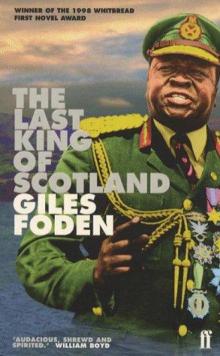 The Last King of Scotland (1998)
The Last King of Scotland (1998) Zanzibar
Zanzibar Turbulence
Turbulence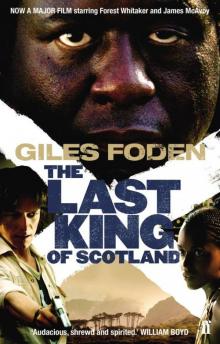 The Last King of Scotland
The Last King of Scotland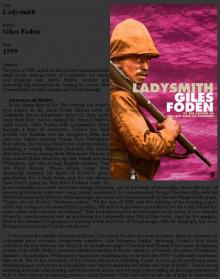 1999 - Ladysmith
1999 - Ladysmith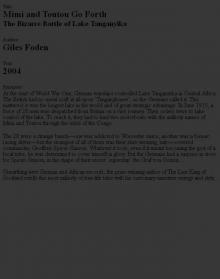 2004 - Mimi and Toutou Go Forth
2004 - Mimi and Toutou Go Forth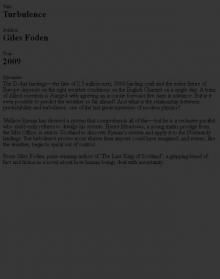 2009 - Turbulence
2009 - Turbulence